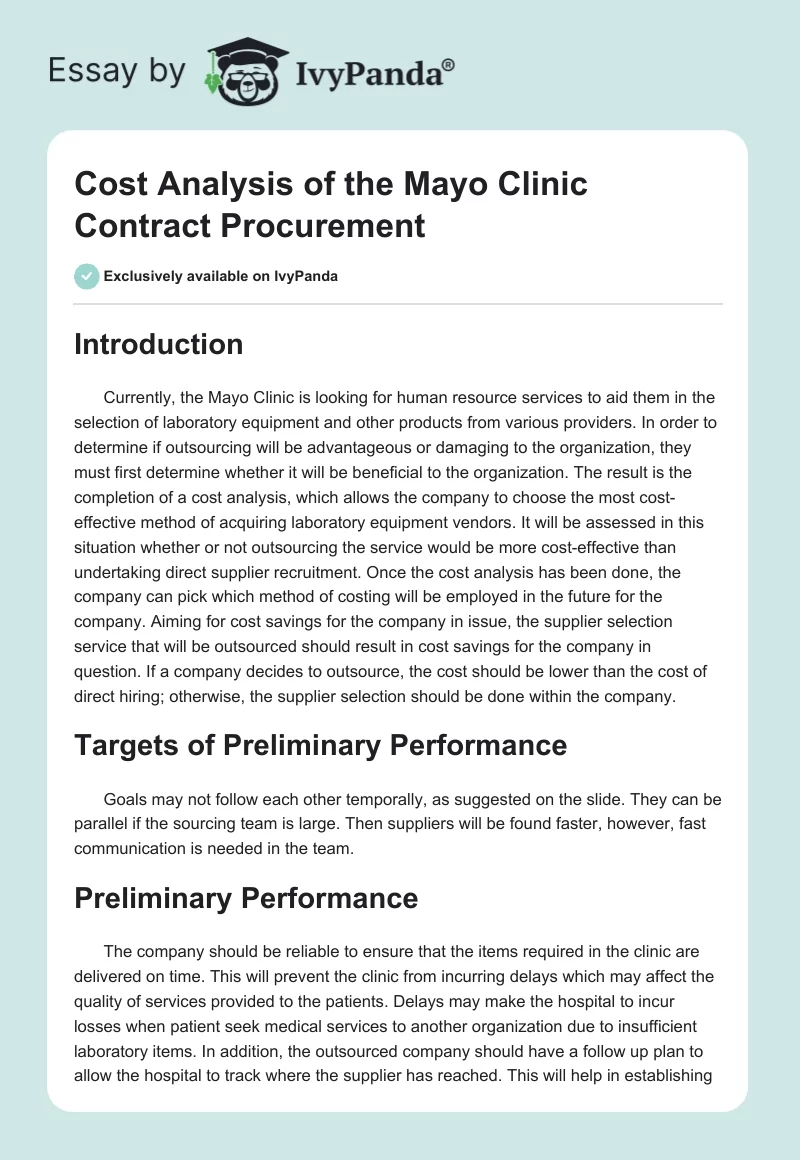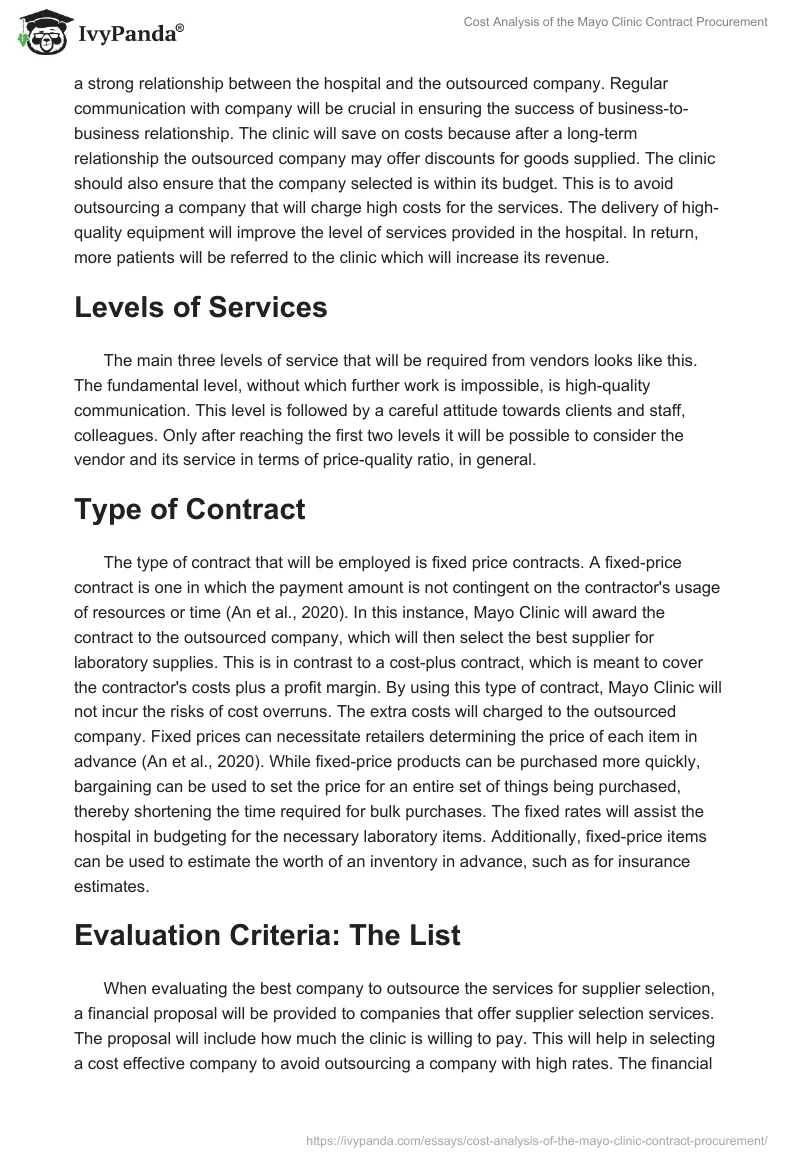Introduction
Currently, the Mayo Clinic is looking for human resource services to aid them in the selection of laboratory equipment and other products from various providers. In order to determine if outsourcing will be advantageous or damaging to the organization, they must first determine whether it will be beneficial to the organization. The result is the completion of a cost analysis, which allows the company to choose the most cost-effective method of acquiring laboratory equipment vendors. It will be assessed in this situation whether or not outsourcing the service would be more cost-effective than undertaking direct supplier recruitment. Once the cost analysis has been done, the company can pick which method of costing will be employed in the future for the company. Aiming for cost savings for the company in issue, the supplier selection service that will be outsourced should result in cost savings for the company in question. If a company decides to outsource, the cost should be lower than the cost of direct hiring; otherwise, the supplier selection should be done within the company.
Targets of Preliminary Performance
Goals may not follow each other temporally, as suggested on the slide. They can be parallel if the sourcing team is large. Then suppliers will be found faster, however, fast communication is needed in the team.
Preliminary Performance
The company should be reliable to ensure that the items required in the clinic are delivered on time. This will prevent the clinic from incurring delays which may affect the quality of services provided to the patients. Delays may make the hospital to incur losses when patient seek medical services to another organization due to insufficient laboratory items. In addition, the outsourced company should have a follow up plan to allow the hospital to track where the supplier has reached. This will help in establishing a strong relationship between the hospital and the outsourced company. Regular communication with company will be crucial in ensuring the success of business-to-business relationship. The clinic will save on costs because after a long-term relationship the outsourced company may offer discounts for goods supplied. The clinic should also ensure that the company selected is within its budget. This is to avoid outsourcing a company that will charge high costs for the services. The delivery of high-quality equipment will improve the level of services provided in the hospital. In return, more patients will be referred to the clinic which will increase its revenue.
Levels of Services
The main three levels of service that will be required from vendors looks like this. The fundamental level, without which further work is impossible, is high-quality communication. This level is followed by a careful attitude towards clients and staff, colleagues. Only after reaching the first two levels it will be possible to consider the vendor and its service in terms of price-quality ratio, in general.
Type of Contract
The type of contract that will be employed is fixed price contracts. A fixed-price contract is one in which the payment amount is not contingent on the contractor’s usage of resources or time (An et al., 2020). In this instance, Mayo Clinic will award the contract to the outsourced company, which will then select the best supplier for laboratory supplies. This is in contrast to a cost-plus contract, which is meant to cover the contractor’s costs plus a profit margin. By using this type of contract, Mayo Clinic will not incur the risks of cost overruns. The extra costs will charged to the outsourced company. Fixed prices can necessitate retailers determining the price of each item in advance (An et al., 2020). While fixed-price products can be purchased more quickly, bargaining can be used to set the price for an entire set of things being purchased, thereby shortening the time required for bulk purchases. The fixed rates will assist the hospital in budgeting for the necessary laboratory items. Additionally, fixed-price items can be used to estimate the worth of an inventory in advance, such as for insurance estimates.
Evaluation Criteria: The List
When evaluating the best company to outsource the services for supplier selection, a financial proposal will be provided to companies that offer supplier selection services. The proposal will include how much the clinic is willing to pay. This will help in selecting a cost effective company to avoid outsourcing a company with high rates. The financial proposal should as well be transparent to that the company being outsourced is aware of the budget of the clinic. The company should have the supplier information and databases to track them incase the clinic has a complain. For example, if a supplier delivers faulty items, the clinic should have means of reaching out to them through the outsourced company to replace the items. This will prevent the clinic from incurring losses. Different criteria will be applied to different business units as they have different tasks, responsibilities and areas of activity. These units are associated with completely different areas of business, and somewhere constant communication is needed, and somewhere it can be minimized thanks to technology. It is impossible to fit all units under the same criteria.
Number of Vendors
Mayo Clinic will outsource only one vendor. In addition, the organization will identify the appropriate vendors to deliver the laboratory supplies necessary by the clinic. One business will enough, as the hospital’s objective is to save money by cutting its expenses. As a result, if a single firm is capable of providing all essential services, there is no need for two or more enterprises to select suppliers. The outsourced organization will bear the cost of searching for and selecting the best suppliers. The clinic will only pay the amount agreed upon when the contract is signed.
Comparison of Cost Analysis
When comparing the cost effectiveness and the cost benefit, the cost measure for both is expressed in terms of financial resources. When comparing cost effectiveness and cost benefit, the cost effectiveness benefit is assessed in units of effectiveness to the organization, while the cost benefit is measured in the monetary value benefits the company receives (Aamer, 2018). This because it provides the benefits in monetary terms, the cost benefit analysis is used to determine the value of a contract. The benefits would amount $120,000 in total. Using the benefit-cost ratio formula, BCR = $120,000/$89,000, or 1.348. Given that the value is positive (and the overall benefits exceed the whole expenses), the cost benefit analysis implies that hiring a supplier with the above expenses demands would be a good option for the organization.
Timeline
The activities to be included in the contract between the Mayo Clinic and the company to which they will outsource their services determine the timeline for completion of the contract. Purchases will be planned for 1-2 months, this is one of the initial stages in the timeline, followed by the rest, no less important. The total period of acquisition through select sellers is more than four months, which will need to be reduced to three months in the future. This period includes a request for a response from the seller, vendor selection, communication, and the drafting of the contract.
Communication Details
In general, it is always important to pay attention to the speed of the project flow. Business is entirely based on human needs, is created by human hands, but it is communications that can slow down the process and achieve results. It is also very important to work on conflict management.
Recommendation
The cost analysis is to help Mayo Clinic to determine whether outsourcing for supplier selection helps in saving on costs or not. Based on the findings, I would recommend outsourcing for the organization. This is because it reduce the costs and time incurred when looking for reliable suppliers. Cost benefit analysis is data-driven as it enables evaluation of the contract free of personal biases and opinions. Organizations can utilize cost benefit analysis because they can determine the money value when they decide to outsource their services.
Usefulness of Outsourcing
The use of outsourcing platforms will allow Mayo Clinic to be accessible to more patients, as well as to keep abreast of changes in large areas. This is due to the fact that outsourcing workers can cover very large areas with an information grid.
Conclusion
Advancing forward has resulted in numerous changes for organizations who opt to contract. They have shifted their emphasis in a variety of ways. The primary change has been in how firms see outsourcing and its benefits. When we look back at the origins of partnering with third-party organizations and individuals, we can see that financial considerations contributed a crucial influence. For some organizations, offshoring was solely for the aim of saving money and decreasing costs thus the need for carrying out a cost analysis. Only a few organizations considered outsourcing as a convenience for them to focus on the major issues even though the outsourcing would be more costly. Advancement in technology has enabled most companies to carry out these services internally by digitizing using the latest technologies. Nowadays, significant progress has been made on this front, and organizations are motivated by a variety of factors to advance while delegating some functions to external teams. Based on all of the above, it is considered very rational to use outsourcing in the framework of the discussed medical business. The decision was made to buy from third party outsourcing vendors until the clinic can afford independent and self-sustaining outsourcing.
References
Aamer, A. M. (2018). Outsourcing in non-developed supplier markets: a lean thinking approach. International Journal of Production Research, 56(18), 6048-6065. Web.
An, Q., Wang, P., Emrouznejad, A., & Hu, J. (2020). Fixed cost allocation based on the principle of efficiency invariance in two-stage systems. European Journal of Operational Research, 283(2), 662-675. Web.
Dekker, H. C., Kawai, T., & Sakaguchi, J. (2018). Contracting abroad: A comparative analysis of contract design in host and home country outsourcing relations. Management Accounting Research, 40(1), 47-61. Web.

 4.50
4.50
